
Stella doppia
Roma (Italy)
Sct 127/1250
Digitale (Photoshop)
12/Aprile/2013
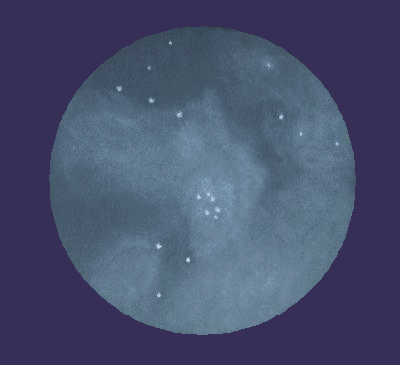
Object Name: M42- Trapezium
Object Type: Nebula
Constellation: Orion
Location: Fredericksburg, Texas
Date: 02/07/13
Time: 21:20 CST
Conditions: Clear; Breezy
Seeing: 3/5; Transparency: 4/5
Equipment: 280mm SCT, 12.5mm EP
Power: 224x
FOV: 12′
Medium: Graphite pencil and Blending Stump on white paper. Photographed and color inverted.
I know this is a popular object. It’s beautiful in just about any telescope even from a light polluted area. But from a dark sky site (near 7 mag) like the one I was at it is unbelievable. So rich in nebulosity my sketch barely does it justice. At about 1400 light years and a diameter of some 24 light years this stellar nursery is fascinating! I have read that, besides being one of the closest star forming regions, the brightest stars and the youngest ones may be only 100,000 years old. I never tire of observing the Great Nebula!!!!
John E.
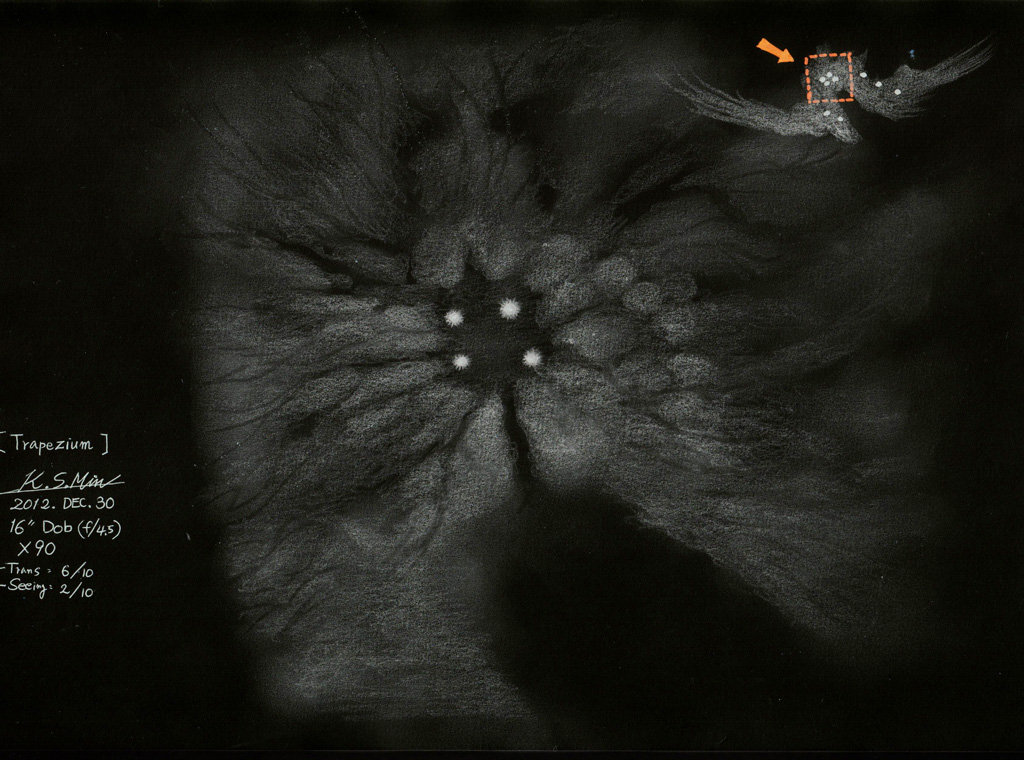
My main observing objects are moon & planets, and I do not invest much time in observing DSO.
But whenever winter season comes, I used to aim my telescopes at the Great orion nebula .
This December, I have observed it 3 times ( 3 day ) with a 16 inch Meade starfinder Dobson , and unfortunately all 3 nights were in bad seeing, the 4 stars in the Trapezium were looked like fat cottons.
Even this seeing condition with a little-bit light polluted site , environs nebula structures were seen quite well .
—————–
16 inches dob reflector x 90
date; 3 weekends in DEC. 2012
location; at backyard home in South korea
media; graphite pencils , a white A4 printer paper
inverted image
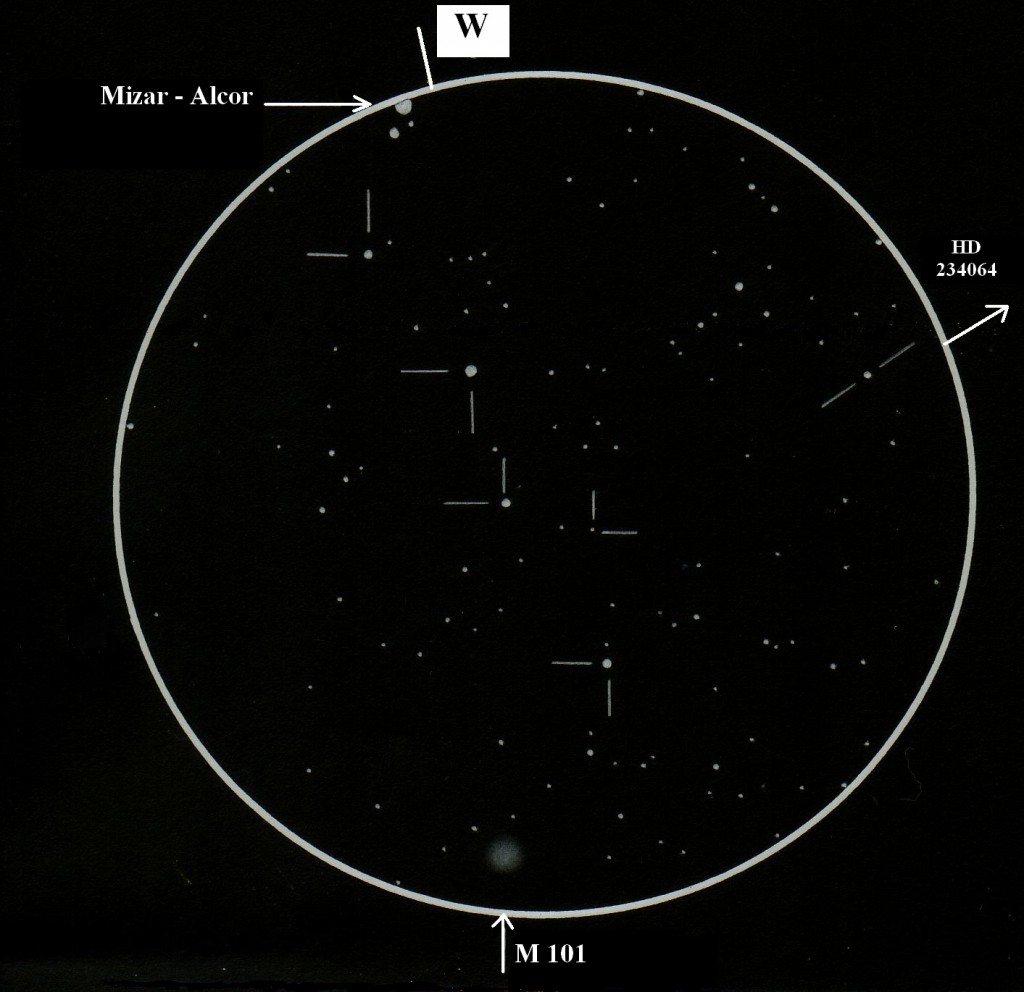
Object: Latysev 2 (possible moving cluster, UMa)
Date: 14. March 2007.
UT.: –
Equipment: 10×80 TZK binocular
Mag.: 10x
FOV: 6˚ x 6˚
Observer: János Gábor Kernya
Location: Sükösd, Hungary
Latysev 2:
„This is a possible moving cluster of seven stars, first suggested by Latyshev (1977). It was identified by considering the space motion of several nearby (GJ, or Gliese Catalogue) stars in this area. The stars cover an area of 3˚ by 3,5˚, including primarily the line of four bright stars between ζ UMa (Mizar and Alcor) and the galaxy M101. These are 81, 83, 84 and 86 UMa. The other 3 stars are HR 5169, HD 234064, and HD 234073. The magnitude range is from V = 4.66 (83 UMa) to V = 10.3 (HD 234073), summing to V = 3.67 and B = 4.05.
Brent A. Archinal – Steven J. Hynes: Star Clusters
(Willmann-Bell, Inc.)
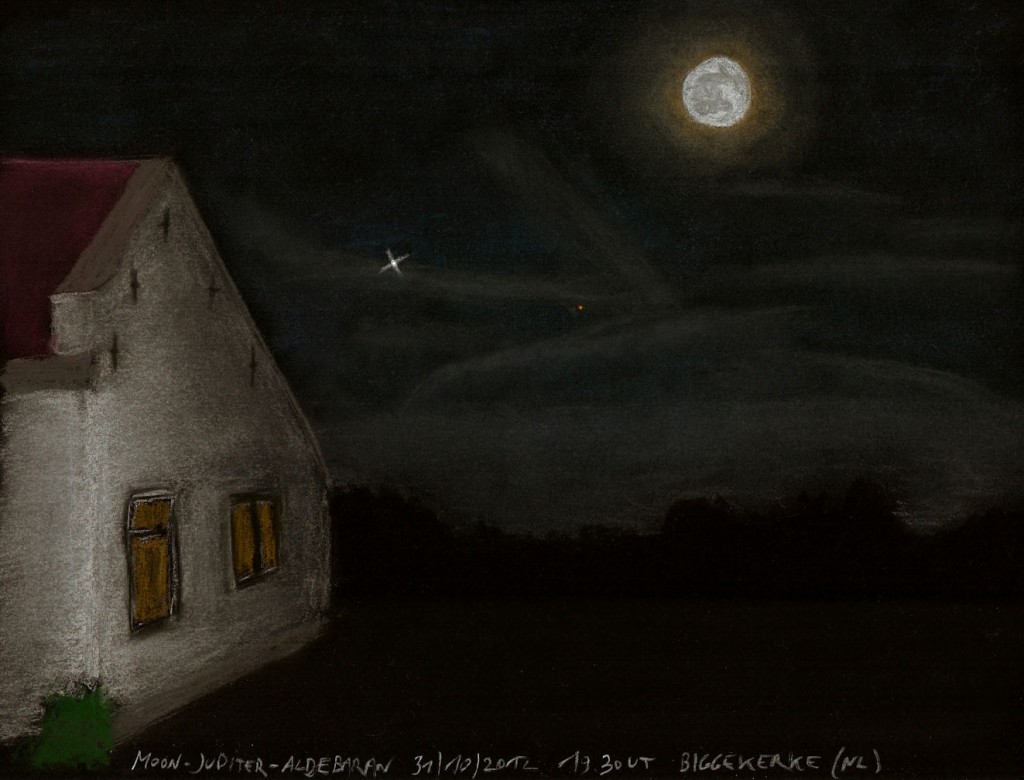
At the last day of October I sketched a beautiful conjunction between the Moon, Jupiter and Aldebaran. The building in the foreground was my holiday-resort (illuminated by a streetlight), a renovated farm from 1669. By chance: in the first months of 1669 Jupiter was also next to Aldebaran in the sky. So the first inhabitants could have witnessed a similar conjunction. To add some more history: the location was less than 10 km from Middelburg, the town where the telescope was invented!
Clear skies
Jef De Wit
Location: Biggekerke, Netherlands (51°29’ N 3°31’ E)
Date and time: 31 October 2012 around 19.30 UT
Equipment: naked eye
Medium: pastel pencils and soft pastels on black paper (A4), Jupiter and Aldebaran were brightened with Paint

Dear Asod,
I send you hereby my sketches of double stars mainly from Virgo, Aquila, Bootes and Lyra. I have observed these double (and multiple) systems on the 14th and on the 28th July. These are all different doubles (or multiples), with different separations from 1,5” to 200”, with different colours. But all can be observed with a small telescope like mine.
Equipment used: 130/650, 26x, 52x, 93x, 130x (different eyepieces).
Media: White paper, graphite pencil, inverted in Photoshop
Date: 14th and 28th July 2012
Place: Budapest, Hungary
Clear Skies,
Judit
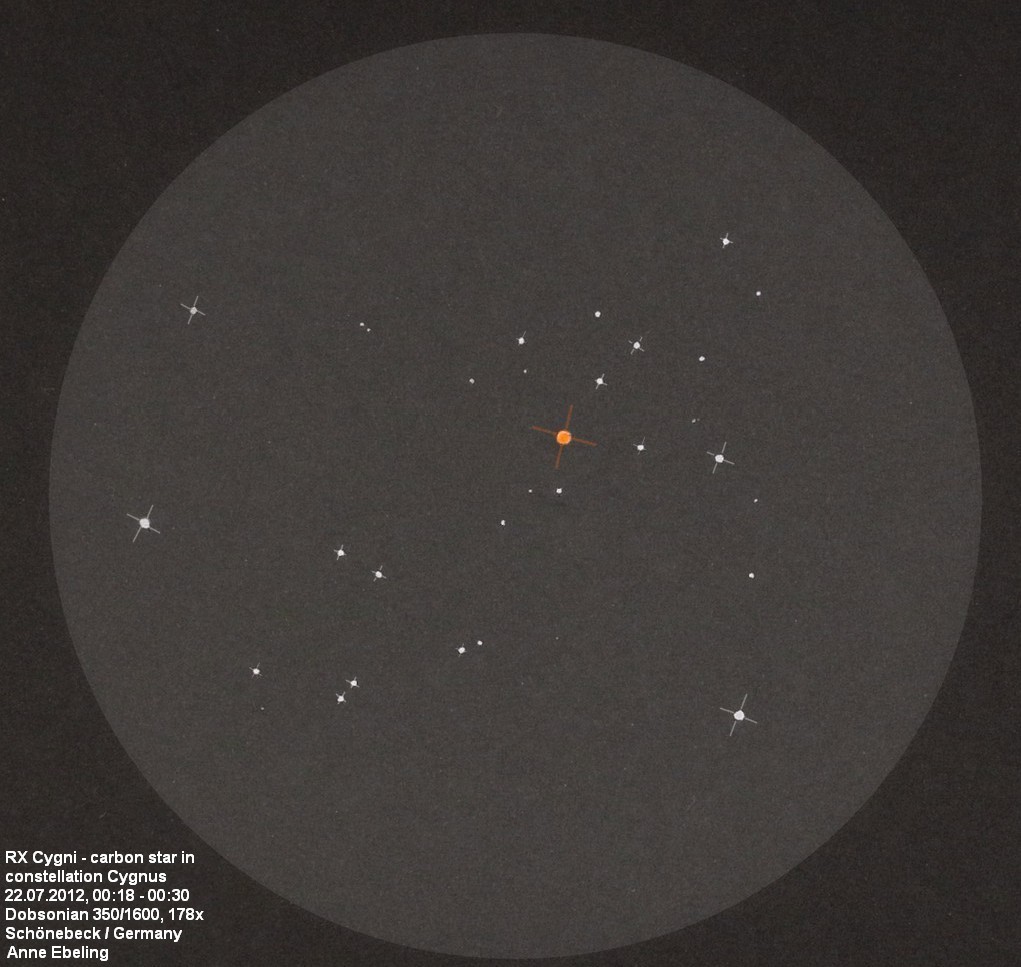
Hi!
I decided to submit a sketch of an extraordinary object: RX Cygni. It’s one of these very red shining carbon stars; nice to observe and unlike other deep-sky-aims, because you easily see colors, even in small telescopes. I suppose the most famous carbon star is R Leporis, which can be found in winter – much more intense than RX Cygni!
Information can be seen in the picture.
Greets – Anne
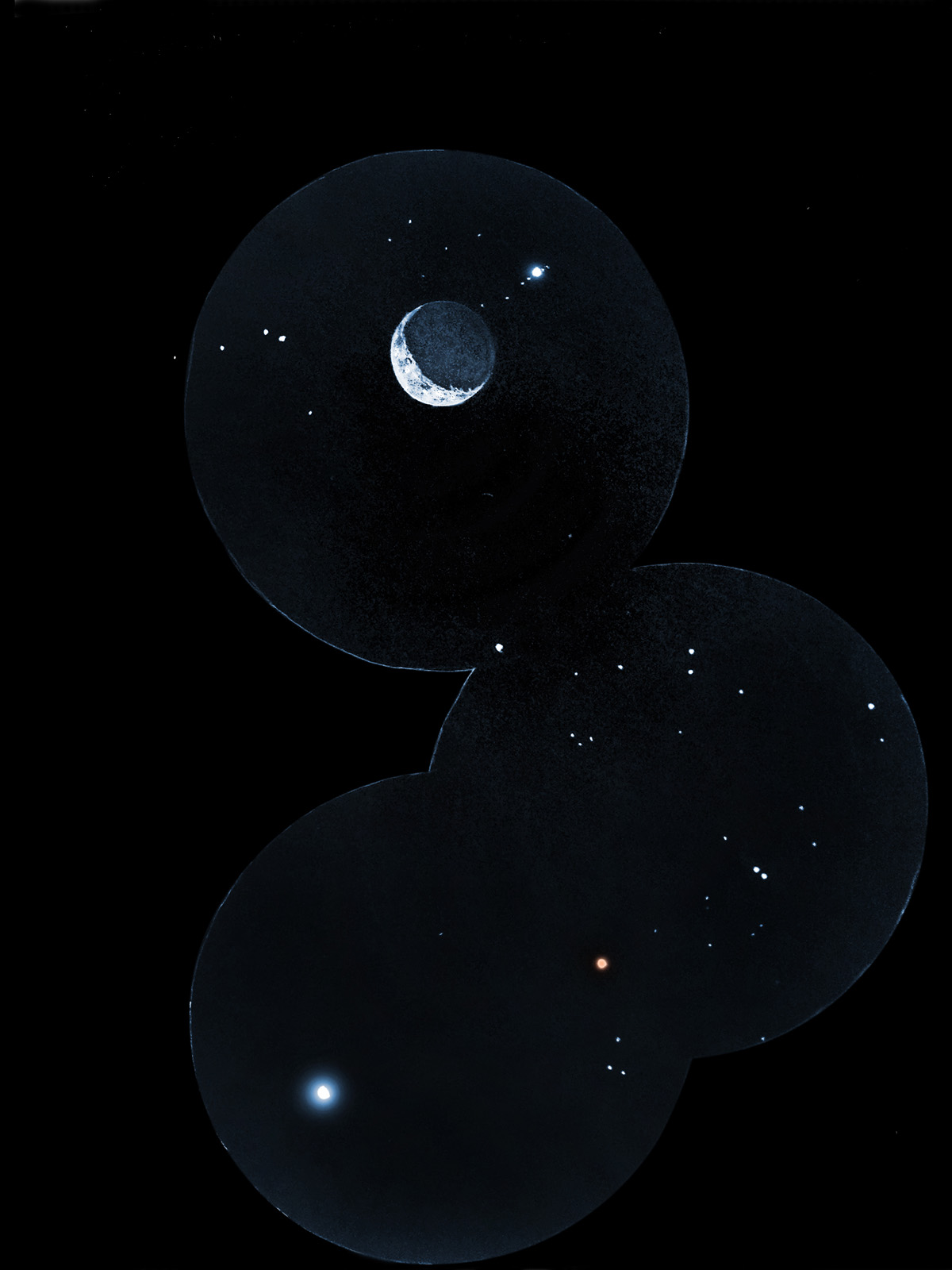
Planetary conjunction at dawn: Venus, Jupiter, Moon, Aldebarán, Pléyades and Hyades.
Drawing made at 5:30 in the morning from the balcony of house in a village near Toledo, Spain.
July 15, 2012
Sketch made with graphite on white paper, inverted with Photoshop.
The sky was crystal clear and pristine,
Alpha
A beautiful sight for the eyes… although it should be up early enough to see.
Hope you like it.
Leonor
—
Visita nuestra web:
ASTRONOMADAS
FUNDACION ASTROHITA: www.fundacionastrohita.org